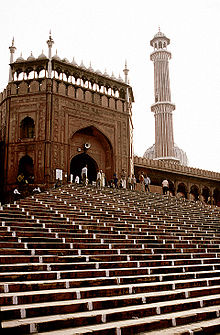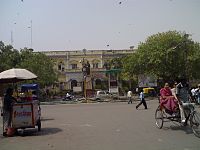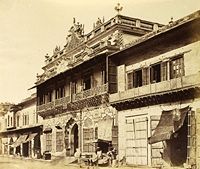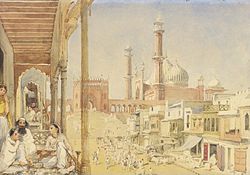- Chandni Chowk
-
Coordinates: 28°39′22″N 77°13′52″E / 28.656°N 77.231°E
Chandni Chowk (Hindi: चाँदनी चौक, Urdu: چاندنی چوک, Punjabi: ਚਾਂਦਨੀ ਚੌਂਕ), originally meaning moonlit square or market, is one of the oldest and busiest markets in Old Delhi, now in central north Delhi, India. Built in 17th century by Shah Jahan and designed by his daughter Jahan Ara, the market was once divided by canals to reflect moonlight, now closed, yet it still remains one of Asia's largest whole sale markets.[1]
Contents
History
 Red Fort, a UNESCO World Heritage Site in Chandni Chowk
Red Fort, a UNESCO World Heritage Site in Chandni Chowk
Chandni Chowk is the major street in the walled city of Old Delhi, which was originally called Shahjahanabad. The walled city, which includes the Lal Qila or Red Fort of Delhi, was established in 1650 AD by the Mughal Emperor Shah Jahan. It was designed by his daughter Jahanara Begum Sahib, who also made significant contributions in the landscaping of her father's new capital.
Chandni Chowk runs through the middle of the walled city, from the Lahori Darwaza (Lahore Gate) of the Red Fort to Fatehpuri Masjid. Originally, a canal ran through the middle of the street as a part of the water supply scheme. It was initially divided into three sections:[2]
 Jama Masjid, the iconic 17th century mosque of Chandni Chowk
Jama Masjid, the iconic 17th century mosque of Chandni Chowk
- Lahori darwaza to Chowk Kotwali (near Gurdwara Shish Ganj): This section closest to the imperial residence, was called Urdu Bazar, i.e., the encampment market. The language Urdu got its name from this encampment. Ghalib noted the destruction of this market during the disturbances of the Indian Rebellion of 1857 and its aftermath.
- Chowk Kotwali to Chandni Chowk: The term Chandni Chowk originally referred to the square that initially had a reflecting pool. It was replaced by a clock-tower (Ghantaghar) that was damaged and demolished in the 1960s.[3][4] This section was originally called Johri Bazar.
- 'Chandni Chowk' to Fatehpuri Masjid: This was called the Fatehpuri Bazar.
It is said that moonlight reflecting on its canal, earned it its name, Chandni (Moonlit).[5]
Chandni Chowk was once the grandest of the markets in India.[6]
The Mughal imperial processions used to pass through Chandni Chowk. The tradition was continued when Delhi Durbar was held in 1903.
 Procession of the Emperor Bahadur Shah II, 1843
Procession of the Emperor Bahadur Shah II, 1843
 Procession of King Edward VII and Queen Alexandra as Emperor and Empress of India, 1903 Delhi Durbar
Procession of King Edward VII and Queen Alexandra as Emperor and Empress of India, 1903 Delhi Durbar
Even though today Chandni Chowk appears choked with congestion, it retains its historical character. The following terms are generally used to describe the buildings and the streets:[7]
- Haveli: a mansion. A normal haveli would have a big courtyard (atrium) surrounded on four sides by spacious rooms and often another walled courtyard around the exterior as well. One of the largest preserved havelis in the area is the Chunnamal haveli.
- Kucha: a zone with houses whose owners shared some common attribute, usually their occupation. Hence the names Maliwara, the gardeners' neighborhood and Ballimaran, the oarsmen’s neighborhood.
- Katra: refers to a separate wing of tradesmen and craftsmen belonging to the same trade. They usually lived and worked together. A system similar to the guild housing in Amsterdam.And it was shown as a favourite city of khushi kumari gupta and home city of arnav singh raizaada in serial iss pyaar ko kya naam doon.
Overview
The area lies in the historically important Shahjahanabad, between the Lal Qila (The Red Fort) and Fatehpuri Masjid. On both sides of the wide Chandni Chowk streets are historical residential areas served by narrow lanes (galis).
With the most famous mosque of Delhi, Jama Masjid, built in 1650 in the vicinity, it is an unusual street that has several famous religious shrines, belonging to different religions, that coexist, lending the street a genuine cultural harmony. Starting from the Red fort, the street has:
- Sri Digambar Jain Lal Mandir, established in 1656 with a bird hospital established in 1929. There is also a Naya Mandir built in 1807 nearby in Dharampura, which was the first temple with a shikhar permitted.
- Hindu Gauri Shankar Temple [8] built by a Maratha general Appa Gandgadhar in 1761.
- Christian Central Baptist Church built in 1814.
- Sikh Gurdwara Sis Ganj Sahib. The 9th Sikh Guru, Guru Tegh Bahadur and his followers Bhai Mati Das, Bhai Dyal Das and Bhai Sati Das were executed nearby by the Mughals in 1675 A.D. The Gurudwaras in the form of memorials were built in 1783 after Delhi, the then Mughal capital, was captured by the Khalsa(the corporate body of Sikhs) under the command of Baba Baghel Singh.
- Muslim Sunehri Masjid built in 1721 by Roshan-ud-Daula Zafar Khan in the reign of Mohammad Shah. The Persian invader Nadir Shah spent several hours on the top of the mosque on 11 March 1739 to observe the Katl-e-Aam (the killing of everyone in sight) that he had ordered which resulted in 30,000 deaths.
- Muslim Fatehpuri Masjid built by Fatehpuri Begum in 1650, one of the queens of Shah Jahan.
Chandni Chowk's specialty is the variety of its markets and their Indian-ness. From authentic Indian food, delicacies and sweets of more than 1,000 kinds, to sarees with chikan and zari work. There are lots of narrow lanes with many shops selling books, clothing, shoes and leather goods, electronic and consumer goods and whatnot. The area, even more so than the rest of the city, is very congested. This is also a good place for window shopping. It is the location of the original Haldiram's. A particular local delicacy are the jalebis, which are fried in pure ghee (clarified butter).
 Gali Parathe Wali in Chandni Chowk is known for its parathas, Dec 2006.
Gali Parathe Wali in Chandni Chowk is known for its parathas, Dec 2006.
Chandni Chowk is home to several famous restaurants/confectioners (halwais).[9]
- The Ghantewala Halwai, established in 1790.
- Natraj’s Dahi Bhalle, established in 1940.
- Kanwarji Bhagirathmal Dalbijiwallah established in mid-19th century.
- Chaatwallah established in 1923, famous for fruit chaat.
- Bikaner Sweet Shop famous for rasmalai.
- Gianiji ka Falooda famous for Rabri Falooda, established around 1947.
- Paranthe wali Gali with paratha shops from 1875-1886.[10]
- Meghraj and Sons, since 1950s (?)
- Chainaram established in 1948
Some of the historical mansions include:[11][12]
- Begum Samru's Palace of 1806 (see [1])now called Bhagirath Palace.
- Naughara mansions in Kinari Bazaar, 18th century Jain mansions.
- Khazanchi haveli, khajanchi were the accountants of Shah Jahan. There is a street named after them called "Gali Khajanchi", a long underground tunnel connects the haveli and the red fort, so that money could be transferred safely.
- Haveli of Mirza Ghalib, Gali Kasim Jan (Gali Ballimaran)
- Chunnamal haveli, Katra Neel
- Haveli of Zinat Mahal, Lal Kuan Bazar
- Haksar Haveli, Bazar Sitaram, where Jawaharlal Nehru was married in 1916 to Kamla Nehru.
- Haveli Naharwali, Kucha Sadullah Khan, where Pervez Musharraf, former president of Pakistan was born.
Chandni Chowk in Indian films
Chandni Chowk was featured in the 2001 Bollywood film Kabhi Khushi Kabhie Gham where the leading lady Anjali (Kajol) and her sister Pooja (Kareena Kapoor) lived. Though portrayed as a neighborhood populated by a lower-class population, Chandni Chowk is shown to be a rich, cultural hub.
 Town Hall, Chandni Chowk with Swami Shraddhanand statue
Town Hall, Chandni Chowk with Swami Shraddhanand statue
The 2008 Bollywood movie Black and White starring Anil Kapoor, Anurag Sinha, Shefali Chhaya, and Aditi Sharma is set in Chandni Chowk.
The 2009 Bollywood movie Chandni Chowk to China starring Akshay Kumar, Deepika Padukone, Mithun Chakraborty, and Ranvir Shorey features some scenes depicting the city.
The 2009 Bollywood movie Delhi-6 starring Abhishek Bachchan, Sonam Kapoor, Waheeda Rehman, Om Puri, Atul Kulkarni and Divya Dutta is set in the ancient Walled City of Old Delhi and centred around Chandni Chowk.
See also
- Dariba Kalan
- Central Baptist Church
- Gali paranthe walee
- Jainism in Delhi
Further reading
- Delhi, the emperor's city: rediscovering Chandni Chowk and its environs, by Vijay Goel. Lustre Press, 2003. ISBN 8174362401.
References
- ^ "Delhi- 100 years as the Capital". The Hindu. Feb 01, 2011. http://www.hindu.com/yw/2011/02/01/stories/2011020150210200.htm.
- ^ Encyclopaedic Survey of Islamic Culture: Growth & Development By Mohamed Taher, Anmol Publications, 1998
- ^ http://www.imagesofasia.com/html/india/chandni-chowk.html Old Delhi Clock Tower built in 1857
- ^ http://www.hindu.com/mp/2007/03/26/stories/2007032600070200.htm The mystique of clock towers
- ^ Chandni Chowk
- ^ Chandni Chowk Scenes from 1814-1876
- ^ http://web.archive.org/web/20071118150017/www.chandnichowk.com/landmark2.htm The Havelis, Kuchas and Katras of Chandni Chowk
- ^ "Gauri Shankar Temple". http://d2i.in/visit/Gauri-Shankar-Temple_Chandni-Chowk_Delhi-NCR_Pilgrimage/2665.
- ^ Chowk and cheese http://www.mid-day.com/lifestyle/2008/sep/280908-Features-Sweets-roza-Chandni-Chowk.htm
- ^ http://www.tribuneindia.com/2002/20021110/spectrum/eat.htm Frozen paranthas posing a challenge to Paranthewali Gali fare
- ^ Havelis of Old Delhi/Text by Pavan K. Varma and Sondeep Shankar. Reprint, First published in 1992. New Delhi, Bookwise, 1999
- ^ Itihas ki dastan hain, Dilli ki havelian http://epaper.hindustandainik.com/blog/uploaded_images/historical_monument_resembles_delhi_haveli-765785.jpg
External links
Neighborhoods of Delhi Ashok Nagar · Ashok Vihar · Ashram Chowk · Ber Sarai · Bank Enclave · Chanakyapuri · Chandni Chowk · Chawri Bazaar · Chittaranjan Park · Civil Lines · Connaught Place · Daryaganj · Dayanand Colony · Defence Colony · Delhi Cantonment · Derawal Nagar · Dhaula Kuan · Dwarka Sub City · Faridabad · Gandhi Nagar · Geetanjali Enclave · Ghaziabad · Gole Market · Govindpuri · Greater Kailash · Green Park · Gulmohar Park · Gurgaon · Hauz Khas · Inder puri · Indirapuram · Kalkaji · Kamla Nagar · Kapasheda · Kashmere Gate · Kirti Nagar · Kotla Mubarakpur · Lajpat Nagar · Lutyens' Delhi · Malviya Nagar · Mayur Vihar · Mehrauli · Model Town, Delhi · Munirka · Najafgarh · Nehru Place · New Friends Colony · Netaji Nagar · New Delhi · Nizamuddin East · Nizamuddin West · Noida · Okhla · Paharganj · Palika Bazaar · Pandav Nagar · Paschim Vihar · Patel Nagar · Pitam Pura · Prakash Vir Shastri Avenue · Preet Vihar · Punjabi Bagh · Karol Bagh · Raisina Hill · Rajouri Garden · Rajender Nagar · Ramakrishna Puram · Rohini Township · Sadar Bazaar · Saket · Sarita Vihar · Sarojini Nagar · Shahdara · Shahdara Maujpur Yamuna Vihar · Shahdara, Delhi · Shahpur Jat · Shalimar Bagh · Shastri park · Shivaji Place · South Extension · Tilak Nagar · Urdu Bazar · Vasant Kunj · Vasant Vihar · Vasundhara Enclave · Vikaspuri · Yamuna Vihar ·
Categories:- Markets in Delhi
- Visitor attractions in Delhi
- Neighbourhoods of Delhi
- History of Delhi
Wikimedia Foundation. 2010.







